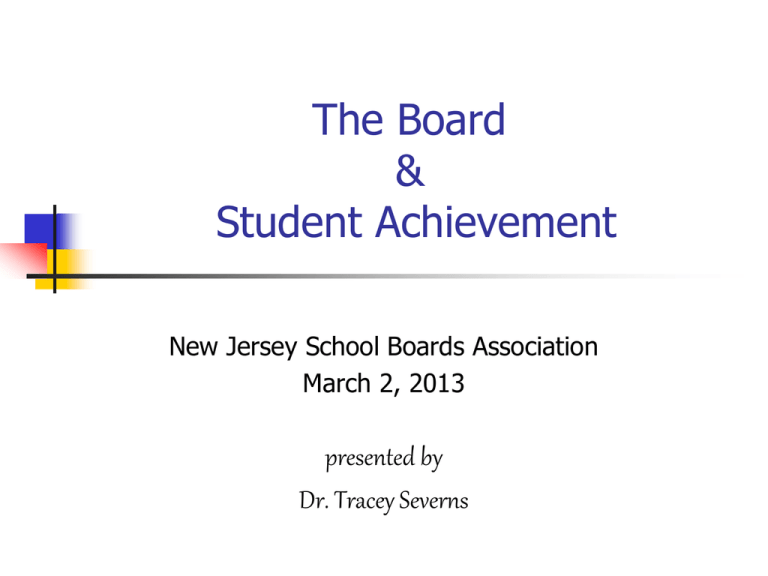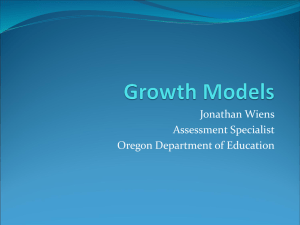data - New Jersey School Boards Association
advertisement

The Board & Student Achievement New Jersey School Boards Association March 2, 2013 presented by Dr. Tracey Severns Introductions – Who am I? Background Check Teacher Vice Principal & Principal Superintendent Researcher Presenter Student Chief Academic Officer for the NJDOE Who are you? What district do you represent? Why are you here? Defining Success What is your definition of a great school? Make it short and measurable. Milton Chen’s definition is… The kids run in faster than they run out. (and so do the faculty!) Consider this… I think that if we changed _____________________, our students’ scores would improve. Without data, it’s just an opinion. Opinions may be your most important data! How are we doing compared to standard in Language Arts? 100 92 90 86 86 80 % Proficient 70 66.1 64.8 60 50 District AYP 40 36.3 30 20 10 0 Gr 4 Gr 8 Grade Level Gr 11 How are we doing compared to standard in Mathematics? 100 90 86 84 80 80 70 61.4 % Proficient 60 50 District AYP 37.5 40 35.6 30 20 10 0 Gr 4 Gr 8 Grade Level Gr 11 “I believe that our system of special education is effective.” 100 90 80 76.75 % Agree or Strongly Agree 70 65 60 55 54 MOMS MOHS 50 40 30 20 10 0 Elem District “I believe if we changed the way we work with special ed. students, they could achieve at higher levels.” 100 90 80 71 % Agree or Strongly Agree 70 60 59 58 MOHS District 51.75 50 40 30 20 10 0 Elem MOMS “I believe the majority of special ed. students can achieve proficiency.” 100 90 80 % Agree or Strongly Agree 70 60 57 48 50 42 40 31.75 30 20 10 0 Elem MOMS MOHS District What opinions do you suffer? Special ed kids are better served in special ed classes. Grouping students by ability improves student achievement. Having one teacher, all day, is the best way to teach elementary school. The students fail because they don’t care. Leaders must use data to: Evaluate progress and performance Establish goals and mobilize efforts Leverage resources Inform practice Guide decision-making Measure, Monitor & Market results Today, we’re going to Examine the role of BOE members in using data to improve student achievement. Learn to ask questions of the data. Establish a baseline With regard to student achievement: What data do you have? What data do you use? Who uses the data? For what purpose are the data used? What data do you need? Identifying the Data Barriers What gets in the way of using data in schools and school districts? What are the obstacles? Data Sources and Key Results Student Performance (classroom quizzes/tests, lab reports, projects, pre/post tests, GPA, performance assessments, standardized tests (norm ref, criterion ref) PSAT, SAT, ACT, AP, report card grades, portfolio pieces, writing assessments, promotion/graduation rates, discipline records, college acceptance, G&T, BSI, honors classes, advanced courses, honor/high honor roll, scholarships, awards, record at competitions/championship) Data Sources and Key Results Demographic data (enrollment and performance by race, gender, SES, ELL, special education, migrant) Climate (exit/entrance interviews, surveys, attendance, extracurricular participation, passage of referendums/school budgets) Resources (personnel, computers, connectivity, time, space, revenues, expenditures) When working with data, use three reference points. How are we doing compared to standard? (Proficiency) How are we doing compared to ourselves? (Progress) How are we doing compared to others? (Relative performance) Adequate Yearly Progress Language Grade Arts/Literacy 3/4/5 Grade 6/7/8 High School Math Grade 3/4/5 Grade 6/7/8 High School Starting Point 2003 2005 2008 2011 2014 68 75 59 (73) 86 100 58 66 72 86 100 73 79 85 92 100 53 62 66 (69) 84 100 39 49 61 80 100 55 64 74 86 100 Performance Targets According to the ESEA Waiver: Targets are set in annual equal increments so that within six years the percentage of non-proficient students in the “all students” group and in each subgroup is reduced by half. Huh? If 40% of “all students” are Proficient: 100 – 40 = 60 60 / 2 = 30 100%P – current %P = gap Gap divided by 2 = target % increase in 6 yrs 30 / 6 = 5 6 yr target divided by 6 = annual target % increase And so… For this school, the expected performance rates would be: Yr Yr Yr Yr Yr Yr 1 2 3 4 5 6 45%P 50%P 55%P 60%P 65%P 70%P More on Performance Targets Targets were based on 2010-2011 data. This process was repeated for each subgroup with an n > 30. High perf grps can meet expectations by achieving 90%P (95%P in 2015). Question Does this process effect every subgroup equally? How are we doing compared to Standard in 5th grade math? School and AYP Gr 5 Math 100 90 80 70 % Prof. 60 Gr 5 School 08 50 AYP Gr 5 40 30 20 10 0 Gr 5 School 08 AYP Gr 5 How are we doing compared to Standard in 5th grade language arts? School and AYP Grade 5 LA 100 90 80 70 % Prof. 60 Gr 5 School 08 50 AYP Gr 5 40 30 20 10 0 Gr 5 School 08 AYP Gr 5 How are we doing compared to Ourselves in Language Arts? NJASK Language Arts Cohort Comparison 100 90 80 70 % Prof 60 Regular Ed 50 Special Ed 40 30 20 10 0 MOMS 06 MOMS 07 MOMS 08 How are we doing compared to Ourselves in Math? NJASK Math Cohort Comparison 100 90 80 70 % Proficient 60 Regular Ed 50 Special Ed 40 30 20 10 0 MOMS 06 MOMS 07 MOMS 08 How are we doing compared to Standard and Ourselves in Language Arts? 2008 NJASK Language Arts Grades 6, 7, 8 100 90 80 70 % Proficient 60 Regular Ed 50 Special Ed 40 30 20 10 0 MOMS Gr 6 MOMS Gr 7 MOMS Gr 8 How are we doing compared to Standard and Ourselves in Math? 2008 NJASK Math Grades 6, 7, 8 100 90 80 70 % Proficient 60 Regular Ed 50 Special Ed 40 30 20 10 0 MOMS Gr 6 MOMS Gr 7 MOMS Gr 8 How are we doing compared to Others? NJASK8 LAL 30.0 25.0 20.0 School Mean 15.0 DFG Mean State Mean 10.0 5.0 0.0 Total Students General Education Special Education LEP Title 1 How would you define comparable? DFG % FARMS % ELL % ELL at home % Special needs Student mobility Teacher mobility Class size Cost per pupil Total enrollment Instructional hours Student/Faculty ratio Student/Admin ratio Where do you stand? School Digger www.schooldigger.com – ranks all NJ public elementary, middle and high schools by adding each school’s average ASK Math and LA scores. Includes a 5 star system to designate schools in the top 10% of the ranking Coping with Education Statistics “There are three kinds of lies: lies, damned lies and statistics.” “Sometimes we accept statistics because we are not in a position to challenge them. Other times we accept them because we lack the time to ferret out the truth.” - Gerald Bracey Simpson’s Paradox Has nothing to do with Homer. Beware of changes in groups over time when the aggregate data show one pattern and the disaggregated data show the opposite. Consider this… SAT Scores 2005 Mean = 480 SAT Scores 2011 Mean = 478 At a BOE meeting, people demand to know, “Why are SAT scores dropping?” But are they? Let’s examine the data SAT Scores 2005 500 500 500 500 500 500 500 500 400 400 Mean = 480 SAT Scores 2011 510 510 510 510 510 510 430 430 430 430 Mean = 478 First, we need to understand that In 2005, the 500s represent scores of white students and 400s represent scores of black students. In 2011, the 510s represent scores of white students and 430s represent scores of black students. What do you notice? White students’ scores went up 10 points. Black students’ scores went up 30 points. but In 2005, 80% were white, 20% were black. In 2011, 60% were white, 40% were black. And so… Although the SAT scores for both groups increased, the overall mean decreased because there was a higher percentage of minority students taking the test. Thus, beware of shifts in subgroup proportion and performance over time. Simpson’s Paradox at work… Ethnic Group White Black Asian Mexican Puerto Rican Am Indian All Students 1995 519 412 474 438 437 471 504 2005 529 433 511 453 460 489 508 Gain +10 +21 +37 +15 +23 +18 +4 Why are our scores dropping? Average SAT Scores 490 485 Scores 480 475 470 465 460 Year They’re not. We’re doing better! SAT Scores by Ethnicity 550 530 Scores 510 490 470 450 430 410 390 White Black Asian Mexican Ethnicity Puerto Rican Am Indian All Students Imagine this. Your superintendent has just presented these results. Write down what you are thinking. Root Cause Analysis Why are we doing better? To what do we attribute the results? Revealing the Root Cause Root cause analysis is the process of identifying the underlying cause, or causes, of positive or negative outcomes within a system. Paul Pruess In other words… Why did subgroups perform as they did? Possibilities include: Organizational issues (time, availability of programs, personnel or support services) Instructional/implementation issues (curriculum, instruction, assessment) Environmental issues (external forces or factors that may have influenced results) Data Analysis What trends do you find in the data? To what would you attribute the results? What questions come to mind when you review the data? What recommendations would you make to improve student performance? A Picture is Worth a Thousand Words and a Million Statistics GEPA Comparison 2003-2005 100 90 80 70 60 50 40 30 Special Ed Regular Ed 20 10 0 2003 2004 2005 Lang Arts 2003 2004 2005 Math 2003 2004 Science 2005 What questions need answers? Do students gain or lose ground over time? Does this vary by track? What patterns exist among teachers? What is the effect of levels in math? What courses, interventions or programs result in gains? For whom? How does question type (multi choice v open-ended) effect performance? What else do you need to know? Are students in BSI improving? Are ELL students progressing? Are G&T students maintaining high scores? What are our Eco Disadvantaged students’ areas of weakness? How does the performance of students with special needs vary by program/placement? How do you get “buy in?” Provide people with the data and invite them to be curious. Understand that “buy in” will follow, not precede, results! Paul Bambrick-Santoyo What is the most effective way to motivate people? a. b. c. d. e. f. Public recognition Private recognition Bonuses Threats Data on personal and team progress Annual performance evaluation As a leader, we must… Develop the “culture and capacity” to use data to improve student achievement. How do you build culture? How do you build capacity? Determine readiness Capacity - Degree of proficiency Assessment literacy Data knowledge and skills Culture - Degree of commitment Emotional climate Group norms Surface predictions and assumptions Where are you? Low Commitment Low Capacity Low Commitment High Capacity High Commitment Low Capacity High Commitment High Capacity Where do you want to be? How do we get there? “The real methodology for system change begins and ends with ongoing, authentic conversations about important questions.” Tony Wagner Michael Fullan suggests… If a system is striving for both high equity and excellence, then policy and practice have to focus on system improvement. This means that a school head has to be as concerned about the success of other schools as he/she is about his/her own school. Sustained improvement of schools is not possible unless the whole system is moving forward. Fullan: Whole System Reform Relentless focus on leadership Small number of ambitious goals Core strategy of capacity building Use of evidence/data Create units of schools that learn from each other Find your “Leadership Focus” (Reeves, 2011) The Law of Initiative Fatigue The key to improving schools is having no more than 6 priorities. As the number of initiatives increases, student achievement decreases (law of diminishing returns). To diagnose “Initiative Fatigue” Divide a piece of paper into two columns. In the left-hand column, list all new initiatives your school or district has begun in the past 24 months. In the right-hand column, list the programs that have been evaluated and terminated. Which column is longer? Prioritize and Pick! It is practices, not programs that change schools. Focus on practices that have: Impact – the potential to exert a significant effect Leverage – the potential to effect multiple outcomes Refer to Visible Learning (Hattie, 2009) for the effect size of various factors that effect learning. Establish SMART goals Specific Measurable Attainable Results-Oriented Time-bound Remember… What gets measured gets managed. Address the Key Characteristics of 90/90/90 Schools (Reeves) A laser-like focus on student achievement Clear curriculum choices – spend more time on reading, writing and mathematics Frequent assessment and multiple opportunities for improvement An emphasis on nonfiction writing Collaborative scoring of student work Role of District Leaders “Simultaneous loose-tight leadership” characterized by “defined autonomy” Articulate clear, nondiscretionary goals Provide strategies for achieving goals Identify the indicators that will be used to monitor the goals Marzano and Waters What’s “tight” in your district? Activity List 3 things that people throughout the district understand are “tight” nondiscretionary priorities that must be observed in every school. Now, compare your answers! Monitoring the Implementation Process Seek evidence regarding: How teachers are organized into teams How teachers are given time to collaborate How the work of teams is monitored How the results of common formative assessments are being used by teams How schools are providing systematic intervention and enrichment. Effective Monitoring (Reeves) Frequent Focused on actions of adults (not just student test scores) Constructive (Is it a witch hunt or a treasure hunt?) Communication is Key! Leaders throughout the district speak with one voice and listen with both ears. Communication must be clear, constant, consistent and congruous (between one’s actions and professed priorities). Conduct a “Communication Audit” What systems ensure that priorities are addressed in each school? What do we monitor in our district? What questions do we ask? How do we allocate resources? What do we celebrate? What are we willing to confront? What do we model? What can you do? Ask questions of the data and seek answers. Do something with the data. Use it to determine district priorities for professional development and allocation of resources (time, personnel, funding, space). Respect the data. Be judicious in the way data is handled and shared. Balance the need to ensure confidentiality and transparency. Does it really matter? Marzano and Stronge’s research: One year with an ineffective teacher takes three consecutive years with a highly effective teacher to catch up. Wrap up and Reflections What are my biggest “take aways?” How will I use what I learned to enhance my service to the district? What are my next action steps? The End Dr. Tracey Severns Chief Academic Officer NJDOE tracey.severns@doe.state.nj.us






